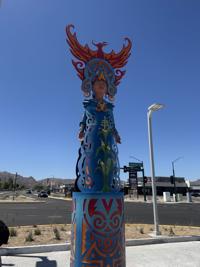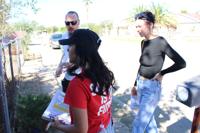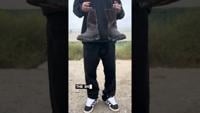
The south Phoenix light rail extension began operating in June 2025. (Yamileth Cabrera / CALÓ News)
Almost two months after Valley Metro’s light rail extension into south Phoenix began operating, community members were invited for a ride along the 5.5-mile, eight-station track to learn about the impact projects like these have on the community, especially for Black and Latino residents who predominantly live in the area.
The event, which functioned more like a field trip for Chispa Arizona members and other local residents, served as a way to get them more familiarized with the light rail system while educating them on the environmental benefits of expanded public transit.
Based in Phoenix with a nationwide network, Chispa is a non-profit focused on building political power and civic engagement among Latinos to push for environmental justice. Through their Clean and Green campaign, Chispa works with leaders, organizations and residents to “prioritize investments in free and electric public transit and infrastructure, urban green spaces, and complete streets.”
The light rail extension, which connects Baseline Road to Third Avenue in downtown mostly via Central Avenue, “aligns with Chispa’s mission because we want to protect the environment and we know that single vehicular use (emits) a lot of air pollution and so when we decide to use public transit I really cuts down the air pollution and it helps our communities be healthier by walking to the light rail, waling to the bus,” Jessica Bueno, CHISPA’s Clean and Green campaign leader, told CALÓ News.
The new stations mirrored the open-air design of the downtown Phoenix stops, featuring long concrete platforms with metal covers that offered some shade and limited seating. Each station included ticket machines, route maps and touches of public art. Light rail fares remain the same, with full day and one-ride tickets ranging from $1 to $4.

At the end of the south Phoenix light rail line, at the Baseline Rd/Central Ave station, riders will find The Mother of Water – Chalchiuhtlicue, a statue by local artist Zarco Guerrero. (Yamileth Cabrera / CALÓ News)
The art was created with input from the community and showcased the work of local artists, like that of local artist Zarco Guerrero, who built "The Mother of Water" monument out of cast bronze and cut steel. It sits at the last stop at the intersection of Baseline Road and Central Avenue.
Still, with so much concrete and minimal shade, the heat was difficult to escape.
Along for the ride was Maricela Pedroza, a Chispa member and Phoenix resident, who said more community members should consider the challenges faced by those who rely on other modes of transportation because they have no other option or choose not to drive a car.
“Think about pedestrians, about those of us who walk, whether we use bicycles or scooters to get from one place to another.” As a community, when weighing in on these projects, it's necessary to take into account those who don't have access to something as common as a car, Pedroza said.
Francisca Carranza agreed. “Many of us who don’t have a car, who don’t have the economic resources to pay insurance and gas on the daily have a need for these services,” she said.
But Carranza didn’t just tag along to enjoy the views. She said the stations could be better, especially since Phoenix experiences extreme temperatures for almost six months of the year.
“I would like to see roof irrigation for people waiting in the heat and some more natural shade,” she said, as she and others who did the ride-along inspected every station they stopped at.
The extension, which took over four years to complete, was not met with full approval from the south Phoenix area, especially when many businesses were impacted within the first year of construction along Central Avenue — like Azukar Café, which had to shut down because barriers positioned along the main corridor dissuaded clients from driving into the area.
According to Bueno, the environmental justice group is not denying those impacts, but rather is focusing on solutions that the city primarily should address, especially as Valley Metro plans out another extension into west Phoenix — impacting the Maryvale neighborhood, where a predominantly Latino population resides — that would connect the area to downtown.
“One of the biggest fears we hear from the community is the gentrification and displacement that comes with infrastructure projects like the light rail. That is definitely a concern, especially as we see housing affordability (diminish). So, we need to come up with solutions around how to really help people, either own their properties, own their businesses or find better solutions for them,” she said.
Bueno said these fears are valid, but asked community members to test out the light rail extension in south Phoenix before making up their minds. “We're trying to champion the transit system to say ‘this is why we need it in all our neighborhoods,’” she said.
















(0) comments
Welcome to the discussion.
Log In
Keep it Clean. Please avoid obscene, vulgar, lewd, racist or sexually-oriented language.
PLEASE TURN OFF YOUR CAPS LOCK.
Don't Threaten. Threats of harming another person will not be tolerated.
Be Truthful. Don't knowingly lie about anyone or anything.
Be Nice. No racism, sexism or any sort of -ism that is degrading to another person.
Be Proactive. Use the 'Report' link on each comment to let us know of abusive posts.
Share with Us. We'd love to hear eyewitness accounts, the history behind an article.